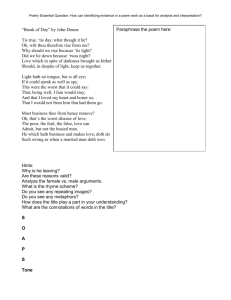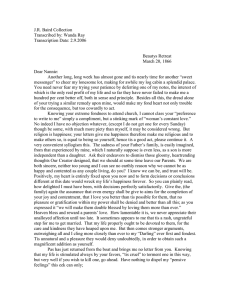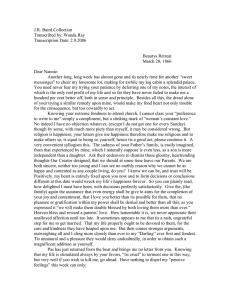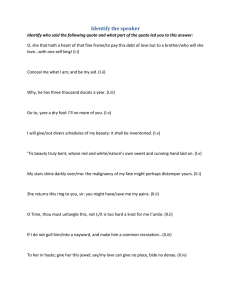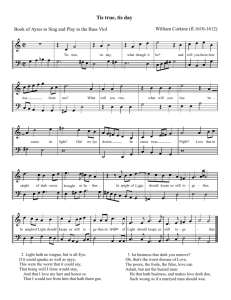Pressure equipment
advertisement
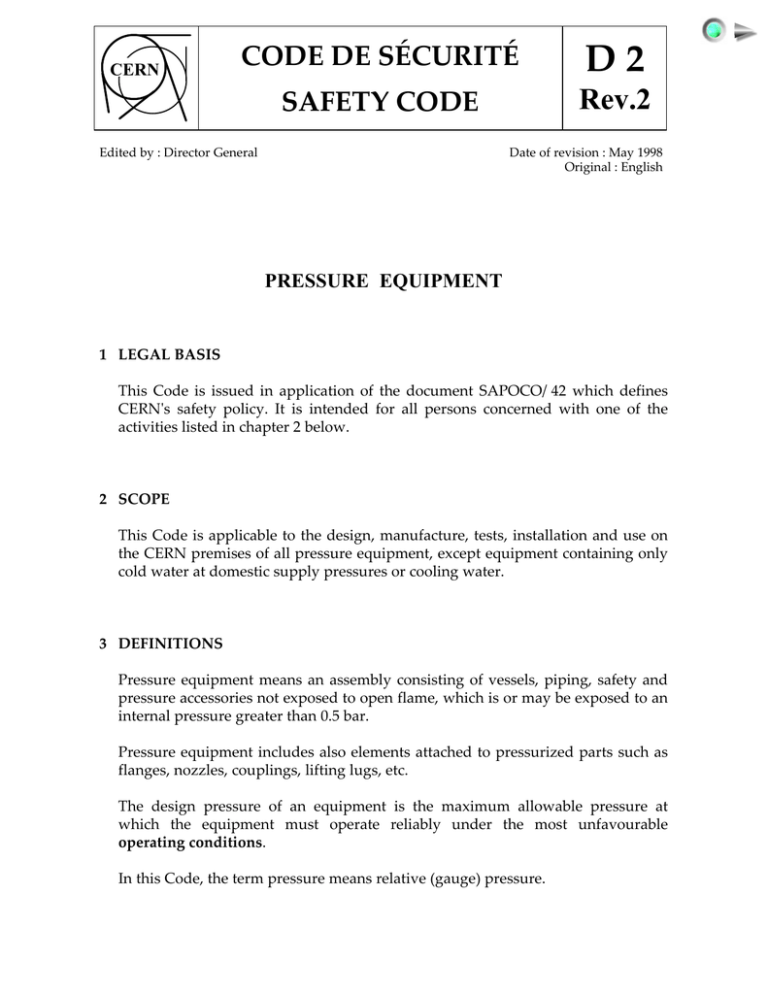
CERN CODE DE SÉCURITÉ D2 SAFETY CODE Rev.2 Edited by : Director General Date of revision : May 1998 Original : English PRESSURE EQUIPMENT 1 LEGAL BASIS This Code is issued in application of the document SAPOCO/42 which defines CERN's safety policy. It is intended for all persons concerned with one of the activities listed in chapter 2 below. 2 SCOPE This Code is applicable to the design, manufacture, tests, installation and use on the CERN premises of all pressure equipment, except equipment containing only cold water at domestic supply pressures or cooling water. 3 DEFINITIONS Pressure equipment means an assembly consisting of vessels, piping, safety and pressure accessories not exposed to open flame, which is or may be exposed to an internal pressure greater than 0.5 bar. Pressure equipment includes also elements attached to pressurized parts such as flanges, nozzles, couplings, lifting lugs, etc. The design pressure of an equipment is the maximum allowable pressure at which the equipment must operate reliably under the most unfavourable operating conditions. In this Code, the term pressure means relative (gauge) pressure. 2 4 PRESSURE EQUIPMENT 4.1 General rules Commercially available (industrial) pressure equipment shall conform to the European Directive 97/23/EC (Approximation of the laws of the Member States concerning pressure equipment) and be delivered to CERN with the appropriate CE conformity and test certificates ("CE" marking) (see also Safety Instruction 42, Compressed Gas Cylinders). Projects concerning special pressure equipment to be used at CERN shall be submitted to TIS for approval (see § 4.2). TIS shall assess the design and verify that this special pressure equipment also conforms to applicable regulations and standards, in order to guarantee a level of safety comparable to that of the European Directive 97/23/EC. Concerning the construction codes and standards for special pressure equipment, the following principles shall be respected: i) for pressure equipment designed at CERN, the French CODAP Code shall be used for their design, construction and testing, independent of the place where their construction is carried out, ii) for pressure equipment to be used at CERN but designed and constructed outside CERN, either the French CODAP Code or the relevant Codes and Standards for the construction of pressure equipment in one of the Member States of the EC shall be used for their design, manufacture and testing. iii) Other construction codes can only be used with the prior consent of TIS. Pressure equipment shall only be designed by technically competent persons who know the safety regulations and the construction standards applying to pressure equipment. It is the responsibility of the project leader concerned to ensure that the person(s) designing pressure equipment have the necessary qualifications. All pressure equipment designed to hold flammable fluids shall conform to the CERN Safety Code G (CERN Flammable Gas Safety Manual). Pressure equipment must be provided with a non-reusable identification plate indicating its relevant characteristics in English or in French. Pressure equipment which holds dangerous substances must be labelled as prescribed in the CERN Chemical Safety Code B. 3 Pressure equipment shall be identified with a number issued by TIS. A set of all relevant documents related to pressure equipment used at CERN shall be filed with TIS. 4.2 TIS approvals concerning pressure equipment All projects concerning the construction of special pressure equipment to be used at CERN shall be submitted to TIS for approval. For this purpose, TIS must receive an ENGINEERING FILE (in English or French) which shall contain : . the design specifications . the choice of material to be used . the operating conditions and procedures for the installation and use of the equipment . the design calculations . a complete set of drawings . the planned safety inspections, safety checks and quality control . a description of the safety devices foreseen (see § 4.3). In the case i) of § 4.1, the ENGINEERING FILE must be prepared by the person at CERN who is technically responsible for the project. The approval of TIS must be obtained before the call for tenders may be sent out or before the order for the construction may be given to the CERN workshops. In the case ii) of § 4.1, the ENGINEERING FILE will usually be prepared by the firm or external body which has taken on the design and/or construction of the pressure equipment. The person at CERN responsible for the technical liaison with the designer or manufacturer must make sure that the ENGINEERING FILE is submitted to TIS in time. The construction of the pressure equipment may only start after TIS has approved the ENGINEERING FILE. For special pressure equipment, or if during the construction of a pressure equipment unexpected problems arise, TIS may require, case by case, additional safety measures to be carried out. The use of pressure equipment for any application different from those originally foreseen shall be approved by TIS. Modifications or repair of pressure equipment shall be approved by TIS. Vacuum vessels which may present a hazard to personnel or the environment (implosion) shall be submitted to TIS for approval. 4 4.3 Safety devices * Pressure equipment must be protected by at least one pressure limiting device. The pressure limiting device must be so designed that the momentary pressure surge will not exceed the maximum allowable pressure by more than 10%. No closing system shall be placed between the equipment and the safety device or on the outlet of the latter. Two safety devices may be mounted on a three-way valve. All safety devices shall be verified by TIS before any pressure equipment (new, second-hand or rented) is put into operation. Air, non-toxic and non-flammable gases may be vented into the ambient air, unless there is a danger of asphyxiation. Toxic gases and gases which present a danger of asphyxiation shall be evacuated via a system, to be approved by TIS, outside the building. Polluting liquids shall be transferred into a suitable storage tank. The vacuum enveloped cryostats and cryolines shall be protected by a safety device set at 0.5 bar. 4.4 Pressure tests Each new pressure equipment shall be subject to a hydraulic pressure test prior to its commissioning. Pneumatic tests must be authorised by TIS. Test pressures shall be: • 1.5 times the design pressure for hydraulic tests • 1.25 times the design pressure for pneumatic tests. For special pressure equipment TIS may specify different test conditions. Pressure tests at CERN shall be organized by the owner of the equipment and performed in the presence of the person(s) responsible for the equipment and a member of TIS who will draw up the test certificates. Pressure equipment constructed outside CERN shall be tested at the manufacturer's premises under the supervision of a certified body of the country where the vessel is constructed, which shall also draw up and transmit to TIS the relevant test certificates. * See also Safety Instruction IS 19/Rev: Safety relief devices for pressure vessels 5 Exceptionally, TIS may replace a certified body for supervising pressure tests outside CERN. In this case the contractor must verify that the proposed tests, pneumatic for example, comply with the rules of his country. The pressure tests must be repeated after : • any transportation of pressure equipment, • any repair or modifications of a pressure equipment, • 10 years • 5 years for pressure equipment containing corrosive fluids, • periodic safety inspections (see § 4.5), when TIS considers this as necessary. The repetition of the tests of pressure equipment will be carried out in the presence of the person(s) responsible for the equipment and a member of TIS who will draw up the test certificates. Retesting of commercial pressure equipment, especially fire extinguishers, will normally be done by the manufacturer. 4.5 Periodic safety inspections Pressure equipment and the associated safety devices shall be inspected and checked by TIS every three years. On this occasion the operating conditions of the equipment shall also be reviewed. Pressure equipment which has not been used for more than two years shall be inspected before being reused. Safety devices (valves) shall normally be re-adjusted by TIS every two years. Rupture discs shall be replaced every two years. Requests for exceptions to these rules must be discussed with and approved by TIS. 4.6 Utilization To ensure safe operation of pressure equipment, the supervisors must provide appropriate instructions and training to the operators (users). Operators (users) must ensure that all pressure equipment and safety devices are correctly maintained. 6 4.7 Maintenance Maintenance of pressure equipment shall only be carried out by experienced personnel (CERN or outside contractors) to be approved by TIS. The rules and regulations laid down in CERN Safety Code A4 (Confined Spaces) shall be strictly observed when entering a pressure vessel for whatever reason. The Division responsible for a pressure vessel shall keep a logbook in which all maintenance reports and/or modification operations must be recorded. 4.8 Incidents or Accidents Any incident with or damage to pressure equipment shall immediately be reported to TIS who will decide upon the actions to be taken (see also Safety Code A2, Reporting of Accidents). 4.9 Shutting down TIS must always be informed when pressure equipment is to be taken out of service. It is strictly forbidden to modify or disable any safety device, to change its calibration or to introduce any modification to the safety system in general. 5 PRESSURIZED PIPELINES Pressurized pipelines shall also conform to the European Directive 97/23/EC and shall be designed, constructed and tested according to : "Recommendation for the design, construction and fitting of pipe installations", drawn up by the "Comité Européen de la Chaudronnerie et de la Tuyauterie" (CECT), and issued by the "Syndicat National de la Chaudronnerie, de la Tôlerie et de la Tuyauterie Industrielle, Maison de la Mécanique, 39-41 rue Louis Blanc, F 92400 Courbevoie". The procedures for non-destructive (X-ray) tests of welds on pressurized pipelines are defined in document TIS/GS/CM/IR/95-03. All new pipelines shall be tested as described in § 4.4 of this Code. However, cold water pipes at domestic pressures and cooling water pipes must be tested by their user on his own. 7 Flexible piping shall have a safety factor of at least 3 with respect to its bursting pressure. Visible pressurized pipelines shall be colour-coded as defined in the CERN Safety Code A3, Safety Colours and Safety Signs. 6. WELDING All welders performing work on pressure equipment (vessels and pipelines) must hold a valid welding certificate for the work to be performed, issued by an official body. These certificates or copies thereof shall be transmitted to TIS. In addition, each welder called in to work on CERN sites must undergo an exam supervised by TIS (see document TIS/GS/IR/94-01, Welders' qualifica-tions for welding work on pressurized pipes and vessels at CERN). For pressure equipment to be constructed outside CERN, the manufacturer shall transmit to TIS the following information about the welding: • • • • • welding material (filler and base material) welding procedures welding qualifications identification of the welder results of destructive and non-destructive tests.
